St Michael and All Angels, Galleywood Common

St Michael’s Church: http://www.stmichaelsgalleywood.org.uk/
St Michael & All Angels, Galleywood Common – Photo index
Front Cover St Michael’s Church
Page 3 St Michael’s parish map
Page 3 Boundary Stone (x2)
Page 4 Bible dated 1873
Page 4 Arthur Pryor - benefactor
Page 4 & 5 Early Images of St Michael’s Church (x4)
Page 6 Tower (x2)
Page 6 Entrance
Page 7 Chancel
Page 7 East Window
Page 8 Triangular panels
Page 8 Tracery (x3)
Page 8 Reredos
Page 9 Mosaic Roundels
Page 9 Sedila
Page 9 Piscina (x2)
Page 10 Holy Table (Altar)
Page 10 Cross
Page 11 Pulpit (x2)
Page 12 Nave (x2) 1908 and 2008
Page 12 Aisles – South (x1), North (x3
Page13 Victorian Tiles, Floor and wall
Page13 Roof
Page13 Brickwork
Page14 Organ Pipes and Console
Page14 Bells
Page 15 Tower Screen (x2)
Page 15 Church Gates
Page 15 Notice Board
Page 15 Toilet s Twinned
Page 16 Welcome desk
Page 16 Porch (x2)
Page 17 Parable of the talents
Page 17 Upper room
Page 17 Lower Room
Page 18 Martin room
Page 19 Vestry
Page 19 Tree of Life (x2)
Page 20 External Views (x2)
Page 20 Churchyard (x2)
Credits: Narrative / words - David Stacy (updated August 2016)
Photographs – Brian R Pepper
St Michael's Church – History and beginnings
The Parish of Galleywood Common was formed by Order in Council dated 20th Oct. 1874 from portions of the Parishes of Great Baddow, West Hanningfield, St Johns Moulsham and of the Parish of Orsett. It covers a scattered area which extends roughly from the Pumping Station (now Fowler Court) on Galleywood Road, to the turning to Wickford on the Stock Road and from Seabrights Farm on the road to Baddow, to and beyond Whites Bridge on the Margaretting Road.

The boundaries were clearly marked in different places by ten boundary stones which bore the inscription ‘G.C., St. M.C.C. 1874’, which being interpreted means Galleywood Common, St Michaels Consolidated Chapelry 1874.

The foundation stone of the church was laid on 21st June 1872 by Arthur Pryor Esquire, of Hylands House, Chelmsford. The edifice was designed by Piers St Aubyn, born in 1815, the second son of the Revd. Robert St Aubyn vicar of Powick near Worcester. He was best known in Devon and Cornwall where many churches rebuilt or restored by him testify to his ability. He died on 7th May 1895 in his 81st year, and was buried at St. Michael’s Mount in Cornwall.
The Church was consecrated on Michaelmas Day, 29th September 1873 by the Bishop of Rochester, in the presence of 750 people who had gathered together from the surrounding parishes.


The cost of the Church, £6,300, was entirely defrayed by Arthur Pryor, who also presented the fine peal of eight bells. These were cast by Warners of London. The tenor bell weighs nearly three quarters of a ton (744 kg). The building is in a 14th century style of architecture. The Chancel is 34 feet long, 17 feet wide and 30 feet high. The Nave is 64 feet long, 18 feet wide and 34 feet high, with North and South aisles of the same length, and 11 feet 6 inches wide, divided by two arcades of four arches each. Transepts project north and south and there is a South Porch 10 feet square.
Early Images of St Michael’s Church




The tower is 18 feet square and 57 feet high with octagonal pinnacles at each angle, boldly buttressed, and surmounted by an octagonal spire of Doulting Stone, 74 feet high. The total height of the Tower and Spire is thus 131 feet, and situated as it is, on a commanding height of 277 feet above sea level, it can be seen for many miles around. The Contractors were Putman & Fotheringham of London and the builder was Mr Patnam.


Entrance

St Michael's Church – Internal features
The Chancel – is the eastern part of the building, from the Latin ‘cancellus’ meaning screen or lattice. Dates from the time when this part of a church was screened off from the congregation – but never in St Michael’s of course.

The East Window– is by Clayton and Bell.

The central panel depicts the risen Christ with his right hand raised in blessing, and holding a victory banner in his left hand commemorating his triumph over sin and death. In the two small triangular panels:

above are the Alpha and Omega, the first and last letters of the Greek alphabet, signifying Christ’s presence at the beginning and end of time (In the Bible, see Revelation chapter I verse 8) This window also commemorates the dedication of the church to St Michael & All Angels. Hilltop churches like these, are often dedicated to St Michael and he appears in the top panel, bearing the sword with which he fought against the dragon (Revelation chapter 12 verse 7). Angels appear in the other tracery lights as well as in the three main lights at the bottom.
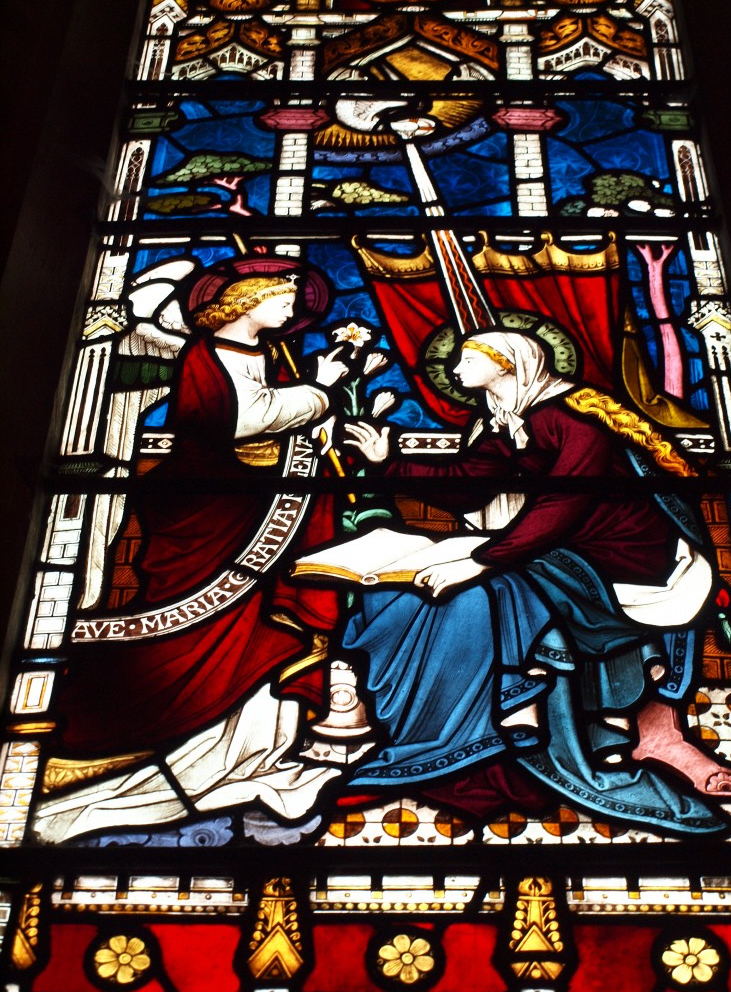
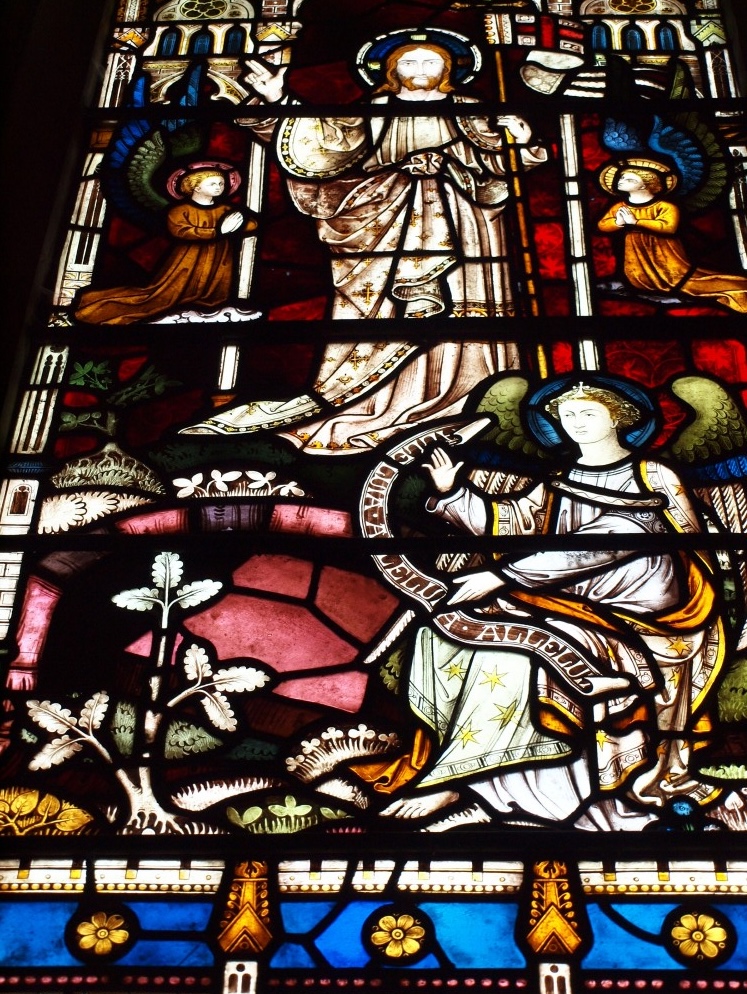

In the left hand main light, the angel Gabriel appears to Mary to announce the coming birth of Christ (Luke chapter 1 verses 26-28); in the centre light an angel guards the empty tomb following Christ’s resurrection from death (Matthew chapter 28 verses 2-7); in the right hand light an angel releases the apostle Peter from prison (Acts chapter 12 verse 7).
Below the East Window is the Reredos by Burrow depicting ‘Christ and the Ministering Angels’.

The Mosaic Roundels – contain abbreviations of the name ‘Jesus Christ’ in the Greek.

The Sedilia – are two arched recesses on the south side of the Chancel, providing seats for use by clergy during the service of Holy Communion.

The Piscina– is situated in the smaller arched recess next to the SediIla and was used for washing the Communion vessels of the end of the service. The drain discharges directly to the ground, as in pre-reformation times, when it was deemed inappropriate for remnants of the consecrated wine to discharge other than into consecrated ground.
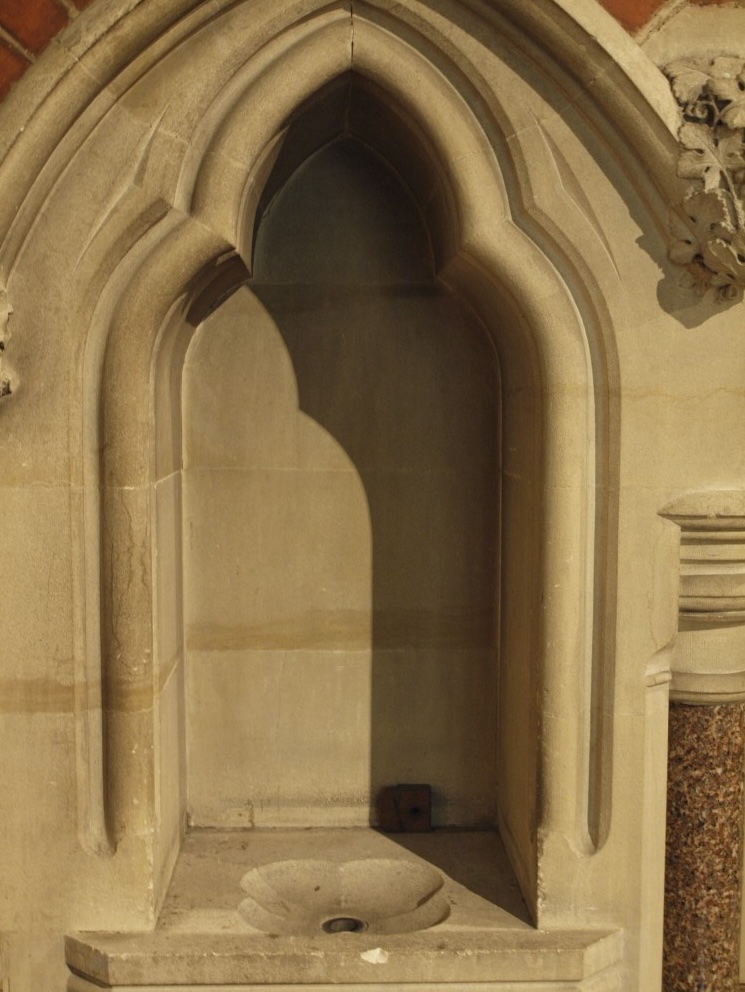

The Holy Table – is the table around which Christian believers gather as a family, to celebrate Holy Communion or The Lords Supper as it is also known – a ceremonial family meal instituted by the Lord Jesus Christ himself for his friends, and on the evening before he was put to death by being nailed on a cross, the Roman means of execution. Because of the remote position of the original Holy Table at the east end of the chancel a smaller portable table and set of rails were introduced in 1988. and these are normally placed forward of the chancel arch and so closer to the congregation.

The Cross– is a common symbol within the Christian Church and it may be found in various forms all around the building. The fact that it is an empty cross is a reminder that Christ’s death was not the end of his life and ministry, but that he is alive today, and ready to welcome all who turn to him in faith for forgiveness.

The Chancel area includes several memorials to early Vicars at St Michael’s together with a Cradle Roll, including some familiar ‘village names’ and some members of the current congregation!

The Font– is traditionally placed near the entrance to the building to signify that entry into membership of the Church is through baptism. This font was first moved from the west end in 1976 and then to its present location in 1988. Parents bringing their children for baptism, and adults being baptised, thus now stand in full view of the congregation and are reminded of the implications of the vows they are making.
The Lectern – formerly stood on the south side of the Chancel arch, opposite the pulpit. It supported two Bibles, one for the Old Testament reading and the other for the reading from the New Testament. It now holds just one Bible, kept open as constant reminder that our faith and actions are to be in accordance with the will of God as revealed to us through the Bible.
The Pulpit – is the place where the preacher stands to explain the message of the Bible, the written Word of God. The words carved into the rail to the pulpit steps are a reminder both to the preacher and the congregation, that fundamental to the life of the Church is the death of our Lord Jesus Christ upon the cross, by which he secures forgiveness and new life to all who trust in him.

 We Preach Christ Crucified
We Preach Christ Crucified
Pulpit Handrail – The original rail was replaced by the Revd F A Roughton (Vicar 1921 - 1958). in memory of his first wife, the late Mrs E B Roughton. Later a Clergy Stall in light oak was given in his memory by his second wife to commemorate his many years of service to the Parish.
Nave – is the main part of the building where the congregation sits – from the Latin ‘navis’ meaning ship, which this part of the church is thought to resemble. The ship is sometimes used as a symbol of the Church in which the faithful are born safely over the Sea of life.


Aisles – are the extensions to each side of the nave, from the Latin ‘aIa’ meaning wings.
South Aisle:


From the Eastern end War Memorial
 Piotrkow Evangelical Christian Church (Poland)
Piotrkow Evangelical Christian Church (Poland)
North Aisle:
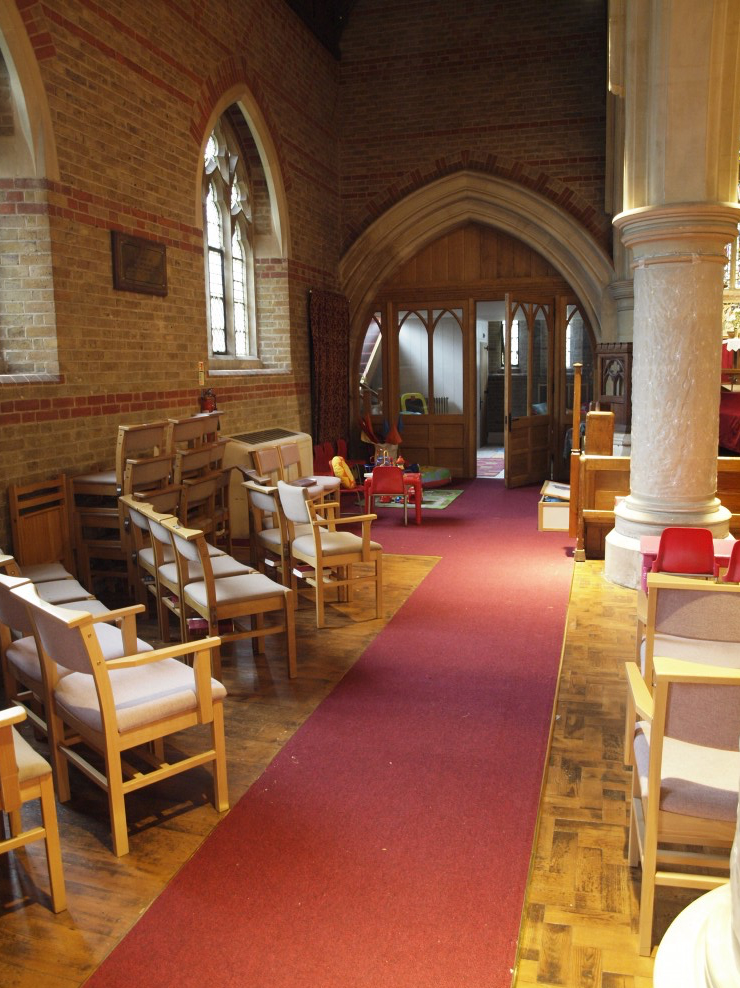 The North aisle is most definitely ‘Child friendly’ and leads to the new Lower Room and additional disabled toilet.
The North aisle is most definitely ‘Child friendly’ and leads to the new Lower Room and additional disabled toilet.
Transcepts – are the extensions at right angles to the main axis of a church from the Latin ‘trans’ meaning across, and ‘saeptum’ meaning enclosure. These are now incorporated in the staging area and the aisles.
Other Internal Features include:
Victorian floor and wall tiles:


The Roof – thought by some to be the best feature of the building. It is entirely of pitch pine and the main trusses are secured with wooden pegs.
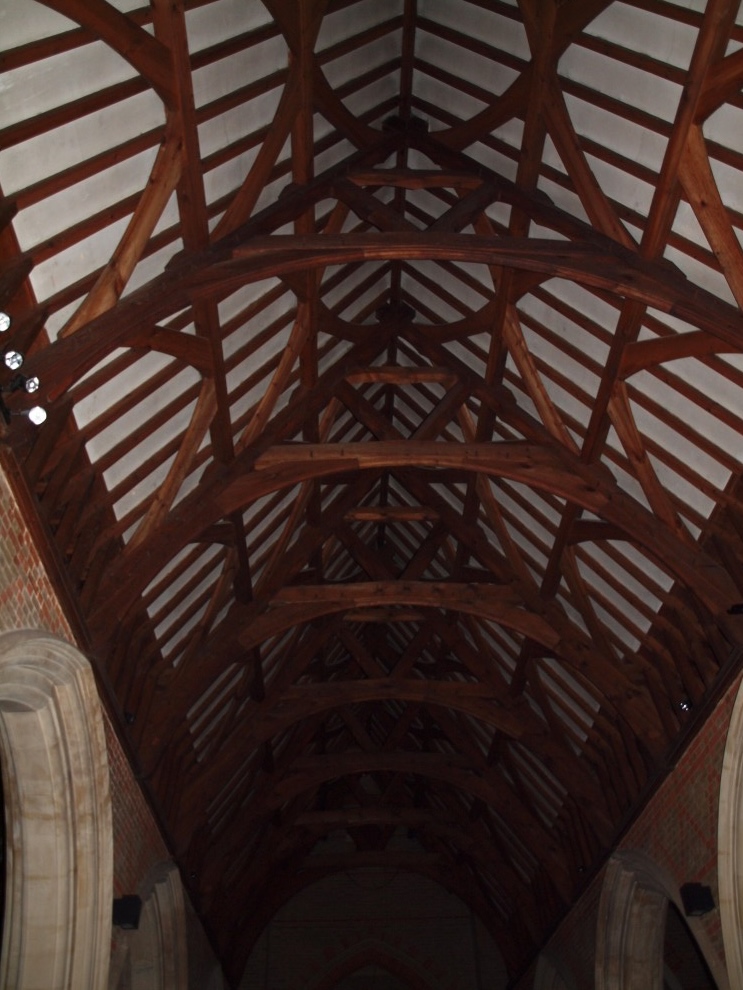

The Patterned Brickwork– may arise from the influence of architect William ButterfieId who was a master of this technique, and who used it to stunning effect at All Saints Church, Margaret Street in London. Here in St Michael’s, perhaps a little more thought was required to ensure that the patterns fitted more comfortably with the other architectural features of the building.
St Michael's Church - Developments over the years.
Lighting – An Acetylene lighting plant was installed in 1908 at a cost of £39. This was replaced in 1935 by electric lighting through the generosity of Mrs Lavinia Keene. In 1966, the Church was rewired and new lighting installed, using fluorescent tubes and tungsten spot lamps, at cost of £540. These units began to fail in 2002 and were replaced by the current lighting installation at the beginning of 2003, at a cost of some £17,000.
# The 2015 project included the upgrading of the lighting to LED halogen units, making the church much brighter and reducing the cost of lighting in the church
Heating – The original heating apparatus was replaced in 1914 – two more radiators being added at the same time. Further improvement was made in I927 and finally in 1957, an oil fired heating system was installed. This lasted until 2007 when the boiler failed and was replaced at a cost of £10,000
Organ – The organ was built by Conacher & Co of Birmingham and was formerly in Slough Parish Church. It was brought to Galleywood in 1924, re-erected and improved by Mr R Mead of Chelmsford and at the same time it was insured for £1,000. It had 23 stops including a 16 ft. Violene on the pedal, and was dedicated on March 1924 by the Bishop of Chelmsford. Then, by a generous gift from Mrs Adams, the organ was rebuilt and the console re-sited in 1953. In 2007 the blower failed and was replaced and asbestos removed from the blower chest

*In 2015 the organ pipes and console were removed from the north aisle and transept by Michael Young, Organ Builders of Great Dunmow. They were refurbished and returned to their new locations; The organ pipes returned to a specially constructed balcony at the west end of the church (in the tower) and the organ console re positioned in the South aisle.


Bells– In 1926, the bells were rehung on ball bearings, the bell frame was strengthened and sally guides were fitted. This work was carried out by Day & Son of Eye, Suffolk at a cost of £147. It was found in 1962 that the bell frame needed to be replaced, and a steel one was then installed, the work being carried out by Mears & Stain bank of Whitechapel at a cost of £1,000.
Tower Screen – This was added in 1955 in memory of Miss Helen Godwin, and later the ringing chamber was fully partitioned off from the nave by a glazed screen.


Church Gates – These were erected in 1956 and dedicated as a token of gratitude to Mrs Lavinia Keene for her great generosity to Church & Parish. The gates were originally surmounted by two wood carvings – a delightful owl on the left and a crown and orb on the right, but alas no more. Nearby is a Notice Board


Toilets– One ‘Elson’ bucket in an outhouse until 1979 when the Church Council decided that the building must be connected to the main drainage. The sum of £15,000 was raised to achieve this, together with the erection of a small kitchen and toilet block at the south east corner of the building. in the Big Project of 2015 a disabled toilet was included in the new room in the North east corner of the church (where the organ pipes used to be) Such modern ‘conveniences’
All three toilets at St Michael’s are twinned:

http://www.toilettwinning.org/
More Recent Changes – A new sound system incorporating a LOOP facility for the hard of hearing was installed in 2000 and a Welcome Desk in memory of Henry Wreathall was given and dedicated in 2003.

Disabled access and facilities have been improved, coupled with a refurbishment of the entrance porch which we have been able to do because of a memorial gift.
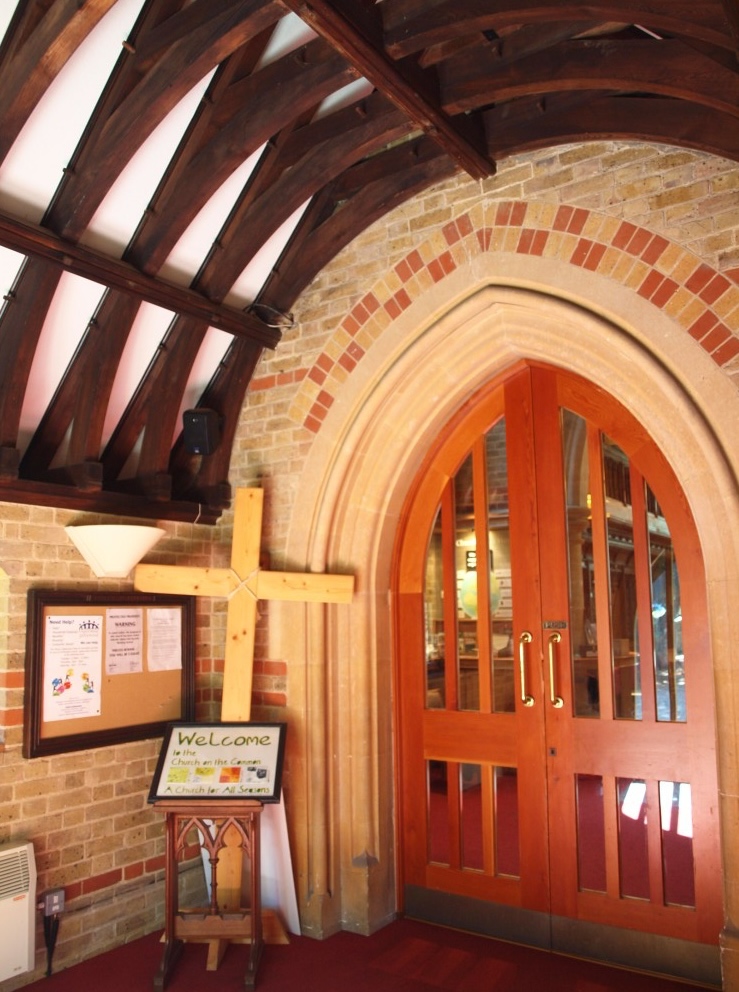
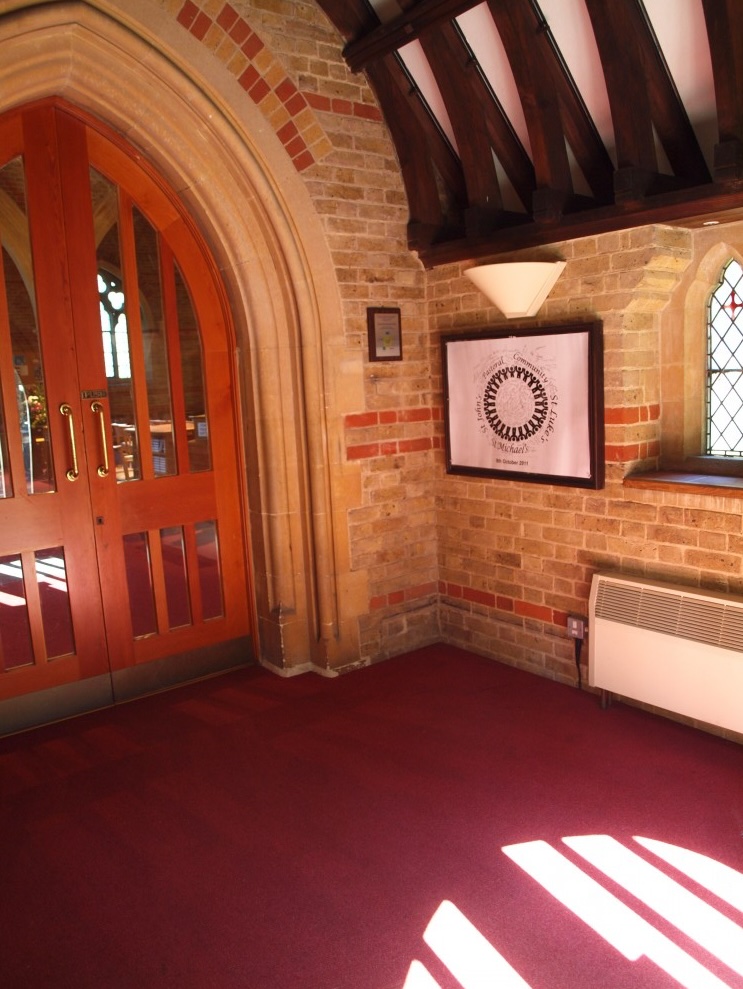
So the present generation continues to care for and enhance Galleywood’s wonderful gift from Arthur Pryor of this Parish Church of St Michael and All Angels
A brass tablet to the memory of Arthur Pryor was put on the north wall of the Church in 1908 and it has been the desire of all concerned over the years that this beautiful building he gave to Galleywood should be maintained in as perfect a condition as possible and improved in keeping with current developments.
St Michael's Church – more recent changes
The BIG Project 2010 – 2015
The ‘Big Project’ had been launched in 2010 with following a sermon by Rev Andy Griffiths based on The Parable of the Talents (Luke: 19. 11-26) A donation of £1000 given by an anonymous donor was handed, in varying amounts, to members of the congregation who were invited to follow the example of the ‘good and faithful servants’ and ‘grow’ their talent.

A substantial part of the proceeds of the sale of St. Michael’s House in Roughtons helped to get the Project underway:
• In August 2014 that the organ pipes were removed from the North-East corner of the church.
• The builders (Lodge and Son) moved in during September and the Church was off limits except for weekends until Easter 2015.
• Two NEW rooms were created in the North Transept (where the organ pipes were), an upper room and a lower room;
Upper Room

Lower Room

• in addition an existing room (at the West end of the church) was enlarged. This is now called ‘The Martin Room’– honouring the work done by Derek Martin as project manager for St Michael's throughout the complex re-building project, liaising with architects (Kay Pilsbury Thomas (KPT) the builders (Lodge & Son) the organ builders (Michael Young) and regularly reporting back to the PCC on progress.


The Martin Room (previously the Choir Vestry) has been transformed into a multi - purpose room
And now has a framed copy of Rembrandt’s ‘The Prodigal’;

The original hangs in the Hermitage Museum in St Petersburg, Russia.
The Theologian, Henri Nouwen has written two books of reflections about the painting:
‘The Return of the Prodigal’ and ‘Home Tonight’
• The Organ Pipes have now been reassembled on a purpose built balcony at the west end of the church, above the Martin room and in front of the bell ringing chamber. (see * above)
• New flooring has been laid in each of the three rooms, ringing chamber and the back of church, with a vinyl floor in the (north) lower room. Most recently the aisles and new areas have been covered with the same red carpet as elsewhere.
New lighting has been fitted which is more effective and more efficient. (see # above)
• Minor alterations have been made to the Vestry– wardrobes and filing cabinets – to accommodate the choir and make the space more usable.

Also there are new items in the kitchen, improving the storage availability and improving the mains water supply and the ability to have an instant hot water dispenser.
Meanwhile in the chancel area, the font was moved from the north side to the south side an oak panel to the north side includes a fine representation of the 'Tree of Life’ carved by Andy Webb.


Our work with children from 0 to 18 has significantly benefitted from these alterations.
Now that the organ has been fully installed and the lighting has been significantly improved we extend an open invitation to come and see what we have achieved in making the church building fit for the future.
Meanwhile, the exterior of the church stands proudly on Galleywood Common where it was constructed in the middle of the Racecourse to counter the evils of gambling:


From the lane at the front to the south west from the north east corner
We also maintain an award winning churchyard, where most days welcomes visitors visiting their loved ones at their final resting place or at our Garden of Remembrance.


 Our logo is the cross, as viewed by those at its foot. This reminds us that when Jesus was dying he saw at the foot of the cross Mary (an older woman) and John (a young man not related to her). “Treat her as your mother, treat him as your son”, said Jesus, thus founding the blended, many-generation church of which we are members today.
Our logo is the cross, as viewed by those at its foot. This reminds us that when Jesus was dying he saw at the foot of the cross Mary (an older woman) and John (a young man not related to her). “Treat her as your mother, treat him as your son”, said Jesus, thus founding the blended, many-generation church of which we are members today.
Jesus, teach us all to love.
This simple phrase sums up our direction and strategy as a church.